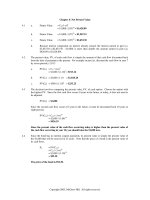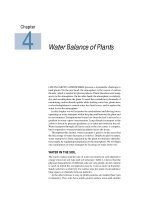Chapter 4 carbohydrates
Bạn đang xem bản rút gọn của tài liệu. Xem và tải ngay bản đầy đủ của tài liệu tại đây (2.09 MB, 54 trang )
Carbohydrates
Carbohydrates
Carbohydrates
Classification
• Simple
Carbohydrates:
– Sugars
• Monosaccharides
• Disaccharides
• Complex
Carbohydrates:
– Starches
– Glycogen
– Fiber:
– Soluble
– Insoluble
Chemist’s view of CHO
• Carbohydrates are made of carbon,
hydrogen and oxygen atoms.
• These atoms form chemical bonds.
Atoms and Bonds
Monosaccharides
• Simple sugars
– Mono: one
– Saccharide: sugar
• General formula C6 H12 O6
Monosaccharides
• Glucose
• Fructose
• Galactose
Monosaccharides
Glucose
Hexagon
Glucose
Disaccharides
• Pairs of Monosaccharides
• One is always GLUCOSE
Disaccharides
• Maltose
• Sucrose
• Lactose
Simple Carbohydrates
How the Disaccharides are
formed ?
Condensation
• Chemical reaction that links two
monosaccharides:
• Water is released by putting together the
two monosaccharides
Condensation
Hydrolysis
• Chemical reaction to split a
disaccharide into 2
monosaccharides
• Needs water
• Happens during digestion
Hydrolysis
Complex Carbohydrates
Complex Carbohydrates
• Few (oligosaccharides) or many
(polysaccharides) glucose units
bound/linked together in straight or
branched chains.
Complex Carbohydrates
• Starch - amylose & amylopectin
• storage form in plants
• Energy yielding - 4 kcal/g
• Glycogen - storage form in animals
but is not a dietary source of CHO
• Dietary fibers Non-energy yielding
Glycogen and Starch
Starch - Amylopectin
Starch - Amylose
Dietary Fiber
• Structural parts of plants not
subject to digestion by human
digestive enzymes
• Some are digested by GI bacteria









